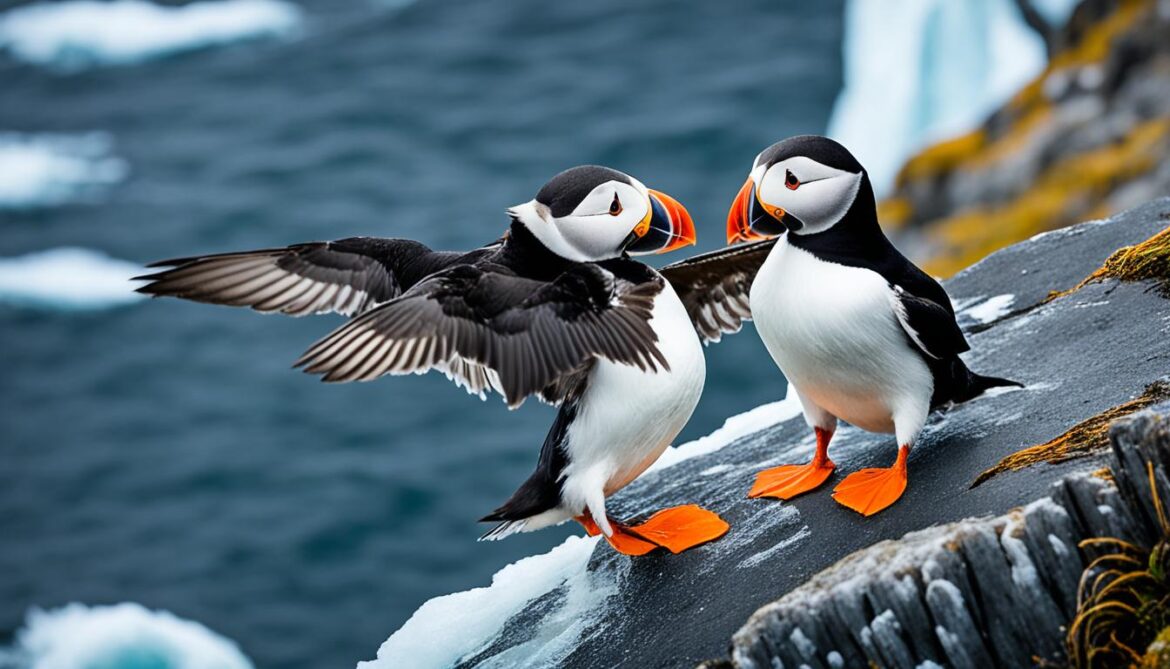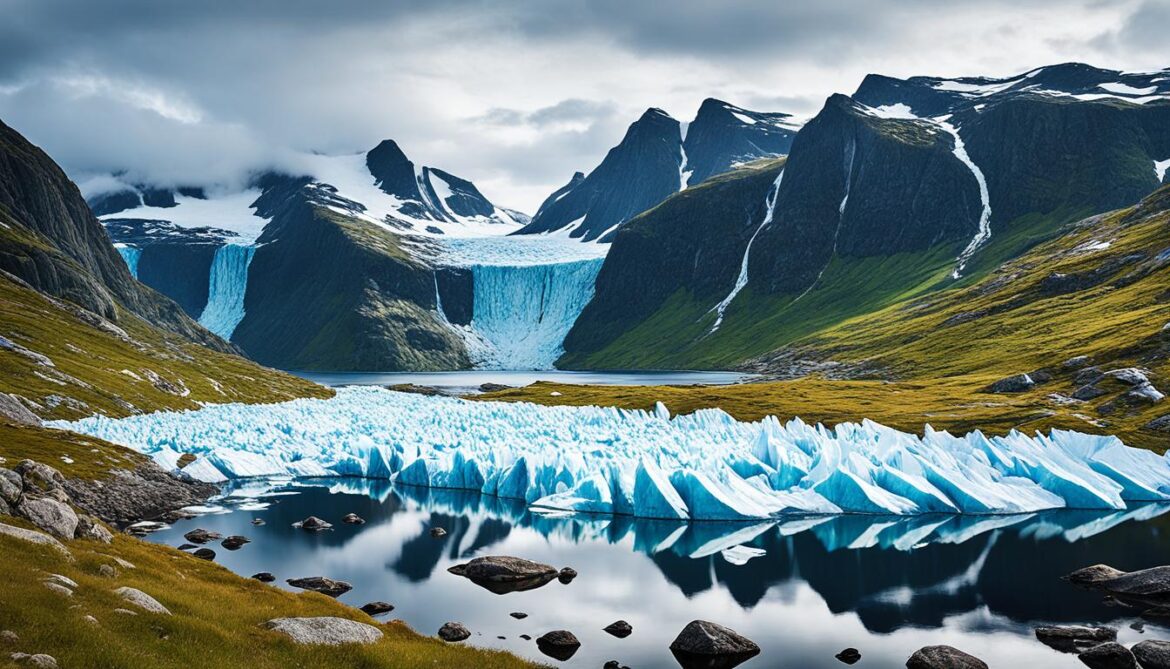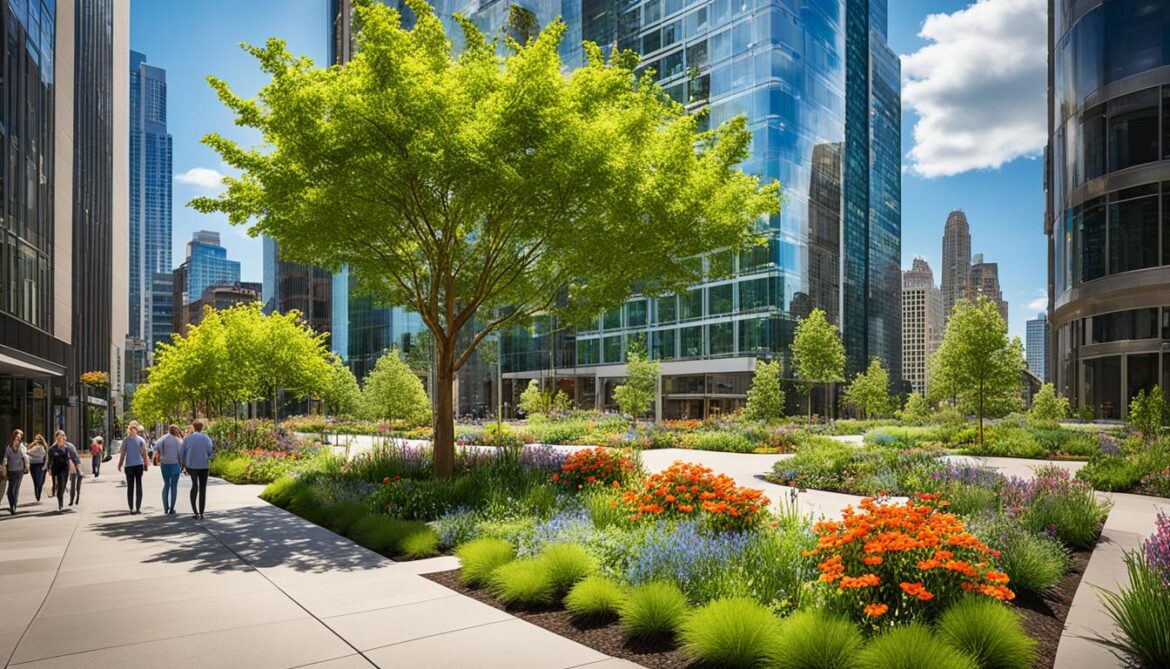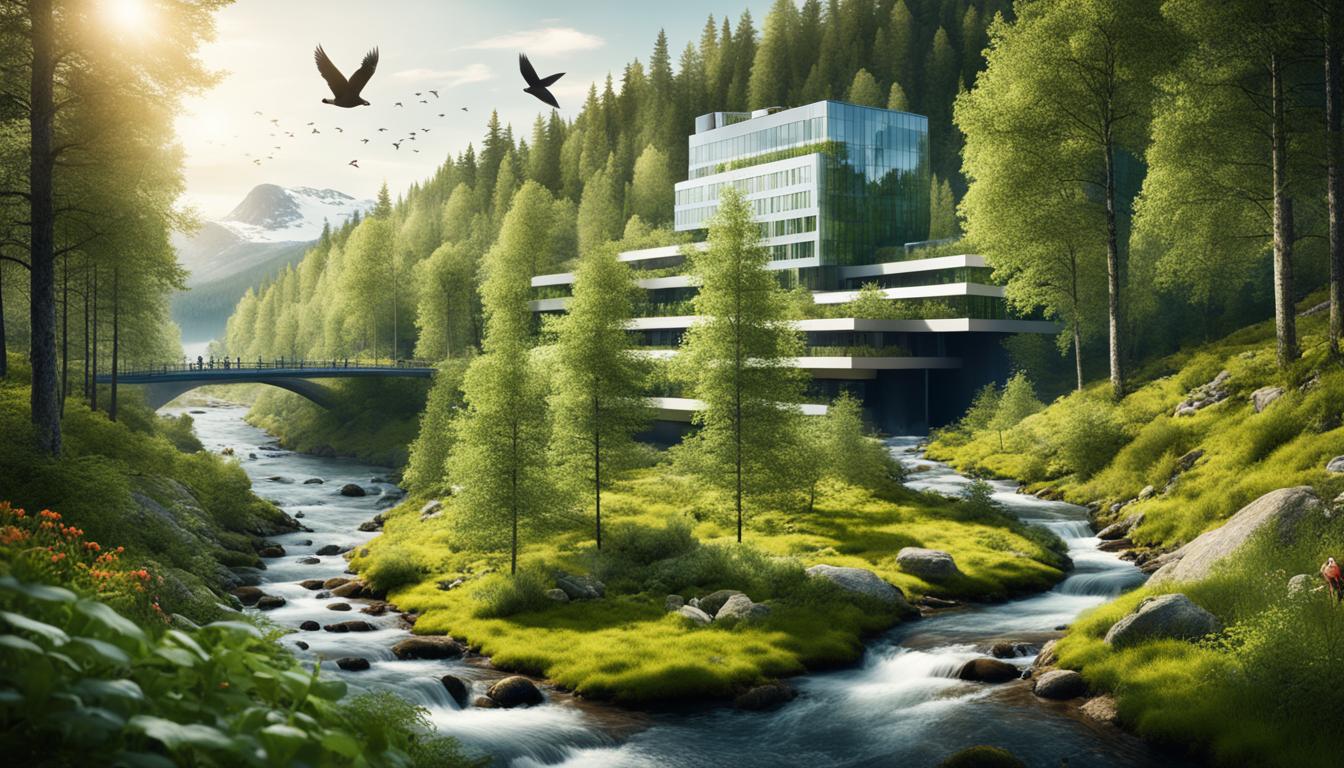Did you know that Norway is home to approximately 41,000 documented species of multicellular organisms? That’s an astounding number, showcasing the incredible biodiversity found in Norwegian ecology. However, with nearly 5,000 species listed as threatened, the conservation of Norway’s biodiversity has become a pressing issue. This article explores how sustainable urban planning, green infrastructure development, and biodiversity conservation strategies are shaping Norway’s urban landscape and making it a leader in urban biodiversity initiatives.
Key Takeaways:
- Norway is home to a diverse range of ecosystems and rich biodiversity.
- Sustainable urban planning and green infrastructure development play pivotal roles in preserving biodiversity in urban areas.
- Norway’s conservation efforts focus on protecting threatened species and enhancing ecosystem resilience.
- The Oslo Urban Ecology Programme is at the forefront of urban biodiversity initiatives in Norway.
- Ecological architecture promotes biodiversity in the built environment.
Biodiversity in Norwegian Terrestrial Habitats
Norway’s terrestrial habitats encompass a wide range of ecosystems, including forests, wetlands, and open lowland areas. Forests play a crucial role in supporting biodiversity, hosting two-thirds of all terrestrial species in the country. However, historical forestry practices and the low number of predators have led to declines in certain species. Wetlands are home to a unique diversity of birds, plants, and insects, but they are also vulnerable, with 275 species listed on the Red List. Threatened species in Norwegian terrestrial habitats include those found in forests, open lowland areas, and wetlands.
Forest Biodiversity in Norway
Forests in Norway are teeming with biodiversity, serving as habitats for a wide variety of species. They play a crucial role in maintaining ecosystem health and functioning. Norway’s forests are home to approximately two-thirds of all terrestrial species in the country, including mammals, birds, insects, and plants. These forests are characterized by coniferous trees like spruce, pine, and fir, providing a unique habitat for a multitude of species.
However, historical forestry practices, such as clear-cutting and monoculture plantations, have led to declines in certain forest habitats and species. These practices have reduced the complexity and diversity of forest ecosystems, impacting the wildlife that relies on them. Efforts are underway to promote sustainable forestry practices that prioritize biodiversity conservation and ecosystem health.
Wetland Biodiversity in Norway
Wetlands in Norway are rich in biodiversity, hosting a unique assemblage of birds, plants, and insects. These habitats play a vital role in water purification, flood control, and carbon sequestration, among other ecosystem services. However, wetlands are also vulnerable, with 275 species listed on the Red List.
Threats to wetland biodiversity include habitat loss, drainage for agricultural purposes, pollution, and climate change. Protecting and restoring wetland habitats is essential for safeguarding the species that depend on them and maintaining the ecological balance. Conservation efforts focus on the conservation and restoration of wetlands, ensuring their long-term health and biodiversity.
Threatened Species in Norwegian Terrestrial Habitats
Norwegian terrestrial habitats are home to numerous threatened species, including those found in forests, open lowland areas, and wetlands. These species are facing various threats, such as habitat loss, fragmentation, pollution, and climate change. The Red List of Norway, which classifies and assesses the conservation status of species, currently lists 2,752 species as threatened out of a total of 4,957 listed species.
Conservation efforts aim to protect and restore habitats, implement sustainable land management practices, and raise awareness about the importance of biodiversity. By addressing these threats and implementing effective conservation measures, Norway strives to ensure the survival and well-being of its threatened species in terrestrial habitats.
Biodiversity in Norwegian Marine Areas
Norwegian marine areas are home to a wide array of marine species, contributing to the country’s rich biodiversity. These areas provide vital habitats for a diverse range of organisms, from microscopic plankton to majestic whales. The marine ecosystems in Norway are teeming with life, with over 12,270 recorded species inhabiting these waters.

Threats to Marine Biodiversity
Despite the abundance of marine life, Norwegian marine areas face significant threats that endanger their biodiversity. The impact of climate change, invasive alien species, and pollution poses grave challenges to these delicate ecosystems. Rising temperatures, ocean acidification, and changes in ocean currents disrupt the natural balance and endanger the survival of many species.
Additionally, the introduction of non-native species, such as the comb jelly Mnemiopsis leidyi, can have devastating effects on local ecosystems by outcompeting native species for resources. Pollution, including oil spills and plastic waste, further degrades marine habitats and threatens the well-being of marine organisms.
Conservation Measures and Marine Protected Areas
In response to the threats facing marine biodiversity in Norway, various conservation measures have been implemented to protect and preserve these valuable ecosystems. Norway actively works towards reducing greenhouse gas emissions to combat climate change and mitigate its impact on marine environments. Policies and regulations are in place to control the introduction and spread of invasive species.
One of the key strategies in marine conservation is the establishment of marine protected areas (MPAs). These designated areas aim to safeguard critical habitats, promote biodiversity, and support the recovery of vulnerable species. MPAs provide a sanctuary where marine life can thrive without the pressures of human activities such as fishing and industrial development.
| Threats |
Conservation Measures |
| Climate Change |
Reducing greenhouse gas emissions |
| Invasive Alien Species |
Regulating the introduction and spread of non-native species |
| Pollution |
Implementing measures to reduce pollution, such as stricter regulations on waste disposal and oil spill response plans |
|
|
These conservation efforts in Norway are crucial for the long-term sustainability of marine biodiversity and the preservation of the country’s marine ecosystems. By protecting these valuable habitats, Norway ensures the continued provision of ecosystem services, such as fisheries, coastal protection, and tourism, that are vital for both the environment and human well-being.
Threatened Species in Norway
Norway’s diverse biodiversity is currently facing significant challenges, with a total of 2,752 species listed as threatened out of the 4,957 on the country’s Red List. These threatened species include the Atlantic puffin, an iconic bird that is classified as Endangered.
The Red List serves as a vital tool in prioritizing conservation efforts and identifying the most vulnerable and endangered species in Norway. It provides valuable information on the species at risk, allowing conservationists to focus resources and implement effective measures to protect and preserve their habitats.
Conservation efforts in Norway are dedicated to safeguarding these threatened species and their habitats. Through various initiatives and strategies, such as habitat preservation, habitat restoration, and species-specific programs, Norway aims to mitigate the impacts of human activities and ensure the long-term survival of these vulnerable species.
One of the species identified as particularly at risk is the Atlantic puffin (Fratercula arctica). This charming bird, known for its distinctive multi-colored beak and comical appearance, relies on Norway’s coastal cliffs and islands for breeding and nesting. Unfortunately, factors such as overfishing, habitat degradation, and climate change have resulted in a drastic decline in the population of Atlantic puffins.
To raise awareness about the need for conservation, the Norwegian government, environmental organizations, and research institutions work together to study the behaviors, habitats, and threats facing the Atlantic puffin. These collective efforts aim to develop effective conservation strategies and ensure the survival of this beloved species.

| Threatened Species |
Number of Species |
Status |
| Total Species Listed on the Red List |
4,957 |
|
| Threatened Species |
2,752 |
|
| Atlantic Puffin (Fratercula arctica) |
|
Endangered |
The table above provides an overview of the number of species listed on the Red List and the status of threatened species in Norway. It highlights the importance of conservation efforts in protecting the country’s biodiversity and underlines the significance of preserving habitats for vulnerable species like the Atlantic puffin.
By addressing the threats facing threatened species and implementing conservation measures, Norway is taking crucial steps towards safeguarding its rich biodiversity and ensuring the long-term sustainability of the country’s natural heritage.
Climate Change Impacts on Norwegian Biodiversity
Climate change poses significant challenges to Norway’s biodiversity, affecting both terrestrial and aquatic ecosystems. The increasing temperatures have profound effects on various species, altering their behavior, distribution, and survival. These changes disrupt the delicate balance within ecosystems and exacerbate existing threats.
Impact on Terrestrial Ecosystems
The warming temperatures have led to shifts in the dynamics of terrestrial ecosystems in Norway. Forests that were historically limited by colder temperatures are now expanding into higher latitudes and elevations, resulting in the invasion of new areas. Conversely, boreal forests are also experiencing retreat due to less suitable climatic conditions.
These changes in forest dynamics have implications for biodiversity, as different species have varying abilities to adapt to new conditions. While some species may benefit from expanded forest areas, others may face habitat loss and reduced suitable environments.
Impact on Aquatic Ecosystems
Climate change also poses threats to aquatic ecosystems in Norway, particularly affecting species such as the Atlantic salmon. Rising temperatures impact the survival, reproduction, and migration patterns of these species, which rely on specific environmental conditions for their lifecycle. Changes in water temperature, river flows, and food availability can disrupt the delicate balance within aquatic ecosystems, leading to population declines.
Adaptation Strategies
To protect and preserve Norway’s biodiversity in the face of climate change, adaptation strategies are crucial. These strategies prioritize ecosystem resilience and aim to mitigate stressors that exacerbate the impacts of climate change.
One key aspect of adaptation is reducing pollution and minimizing other stressors that can further harm ecosystems. By implementing sustainable land management practices, such as responsible forestry and agriculture, Norway can lessen the negative impacts on biodiversity.
Additionally, maintaining and restoring ecosystem functions and habitats are vital for promoting resilience. Protecting critical habitats, establishing connectivity corridors, and enhancing biodiversity hotspots contribute to the long-term survival and adaptation of species.
By addressing climate change impacts on both terrestrial and aquatic ecosystems and implementing adaptation strategies, Norway can safeguard its biodiversity for future generations.

Conservation and Adaptation Strategies for Terrestrial Biodiversity
Conservation efforts for terrestrial biodiversity in Norway focus on preserving and restoring habitats, establishing protected areas, and implementing sustainable land management practices. These strategies play a crucial role in maintaining the delicate balance of ecosystems and safeguarding the diverse range of species that call Norway home.
Habitat corridors serve as vital connectivity pathways between fragmented habitats, enabling the movement and adaptation of species. By providing safe passage across different landscapes, habitat corridors facilitate genetic exchange, reduce the risk of inbreeding, and enhance the long-term survival prospects of numerous plant and animal species.
Protected areas play a significant role in biodiversity conservation by preserving key habitats and providing a sanctuary for threatened species. These designated areas, such as national parks and nature reserves, act as refuges where sensitive ecosystems are safeguarded from human activities, offering a haven for endangered plants and animals. Protected areas also provide opportunities for scientific research, education, and ecotourism, fostering public engagement and appreciation for nature.
Preserving and restoring habitats, establishing protected areas, and implementing sustainable land management practices are essential for the long-term conservation of terrestrial biodiversity in Norway.
Efforts to protect threatened species are paramount to biodiversity conservation. Norwegian authorities collaborate with researchers, local communities, and environmental organizations to identify and implement targeted conservation measures. By implementing measures such as reforestation, habitat restoration, and species-specific management plans, Norway strives to reverse population declines and ensure the survival of endangered species.
Additionally, sustainable land management practices, such as responsible forestry and agricultural practices, help reduce the negative impact on terrestrial biodiversity. By minimizing habitat destruction, preserving soil quality, and promoting sustainable resource use, Norway seeks to maintain a harmonious balance between human activities and the preservation of natural habitats.
Benefits of Conservation and Adaptation Strategies
The adoption of conservation and adaptation strategies yields numerous benefits for both the environment and society. These include:
- Protection of essential ecosystem services, such as clean water, air purification, and carbon sequestration
- Promotion of ecological resilience, enabling ecosystems to adapt to changing environmental conditions
- Maintenance of biodiversity, which contributes to natural beauty, cultural heritage, and recreational opportunities
- Enhancement of sustainable development, where economic growth is balanced with environmental protection and social well-being
In summary, the conservation and adaptation strategies employed in Norway are vital for preserving the terrestrial biodiversity that is an integral part of the country’s natural heritage. By protecting and restoring habitats, establishing protected areas, and implementing sustainable land management practices, Norway upholds its commitment to safeguarding the environment for future generations.
| Conservation and Adaptation Strategies for Terrestrial Biodiversity |
Benefits |
| Preserving and restoring habitats |
Protection of essential ecosystem services |
| Establishing protected areas |
Promotion of ecological resilience |
| Implementing sustainable land management practices |
Maintenance of biodiversity |
Sources:
- Norwegian Institute of Bioeconomy Research (NIBIO)
- Natural History Museum, University of Oslo
- Norwegian Environment Agency

Urban Biodiversity Initiatives in Norway
Norway, and specifically Oslo, is at the forefront of urban biodiversity initiatives. The Oslo Urban Ecology Programme aims to maintain and strengthen the city’s blue-green structure, ensuring environmentally sustainable urban development. Green spaces, including urban forests, meadows, and calcareous islands, play a crucial role in promoting biodiversity and providing ecosystem services.
These green spaces contribute to recreational opportunities, pollination potential, and climate change adaptation. By prioritizing the preservation and development of urban open spaces, Norway promotes sustainable urban planning that celebrates ecological diversity.

Benefits of Urban Green Spaces
Urban green spaces in Oslo provide numerous benefits to both humans and the environment. Some key advantages of these green spaces include:
- Enhanced air quality through the absorption of pollutants
- Improved mental health and well-being
- Reduced urban heat island effect through cooling and shade
- Support for biodiversity, including various plant and animal species
- Provision of recreational and cultural spaces for residents and visitors
These urban green spaces act as valuable ecosystem service providers, contributing to the overall health and resilience of the city.
Oslo Urban Ecology Programme
The Oslo Urban Ecology Programme is a comprehensive strategy that focuses on integrating nature into urban areas, creating a harmonious balance between human development and the preservation of natural habitats. The program emphasizes:
- The creation and maintenance of green corridors to connect and restore fragmented habitats
- The enhancement of biodiversity through the creation of diverse and sustainable green spaces
- The promotion of environmental education and citizen engagement in urban ecology
This holistic approach ensures that the benefits of urban biodiversity are accessible to all residents, while also raising awareness about the importance of ecological conservation.
“Our aim is to create a city where citizens and nature can coexist in harmony. By prioritizing urban biodiversity initiatives, we are not only preserving our natural heritage but also enhancing the quality of life for our residents.” – Oslo Urban Ecology Programme
Case Study: Frogner Park
Frogner Park, located in the heart of Oslo, is an excellent example of how urban green spaces can contribute to biodiversity conservation and ecosystem services. With its beautifully manicured lawns, diverse tree species, and carefully designed flowerbeds, the park offers a haven for numerous plant and animal species.
The park’s ponds and water features support aquatic life, further enhancing the ecological diversity. Visitors can witness the park’s rich biodiversity while enjoying various recreational activities, such as walking, picnicking, and birdwatching.
Frogner Park is a testament to the successful integration of urban development and biodiversity conservation, providing a model for sustainable urban planning.
The Value of Ecosystem Services
Urban green spaces in Oslo provide a range of ecosystem services that contribute to the well-being of both humans and the natural environment. These services include:
| Ecosystem Service |
Description |
| Recreation Opportunities |
Urban green spaces offer residents and visitors opportunities for outdoor activities, exercise, and relaxation. |
| Pollination Potential |
Green spaces support diverse pollinator populations, ensuring the successful reproduction of plants and crops. |
| Climate Change Adaptation |
Urban green spaces mitigate the impacts of climate change by reducing heat island effects, managing stormwater runoff, and sequestering carbon. |
These ecosystem services are vital for maintaining a healthy and sustainable urban environment, enriching the lives of both humans and the diverse range of species that call Oslo home.
Mapping and Assessing Ecosystem Services in Oslo
The Oslo city lab has been actively involved in mapping and assessing ecosystem services in the urban environment of Oslo. With a specific focus on recreation potential and pollination, the city lab utilizes the ESTIMAP methodology to model and analyze these vital ecosystem services.
The recreation potential mapping conducted by the city lab provides valuable insights into the spatial distribution and accessibility of recreational opportunities throughout Oslo. This assessment helps identify areas that can be further developed or optimized to enhance the well-being and enjoyment of residents and visitors alike.
The pollination potential mapping, on the other hand, delves into understanding the availability and effectiveness of pollinators in the city. By mapping the pollination potential, the city lab can identify areas where pollinator-friendly habitats and management practices can be prioritized to support pollination services and mitigate the decline of pollinator populations.
The data generated through the ecosystem services assessment by the Oslo city lab plays a critical role in informing decision-making, urban planning, and conservation efforts in the city. By understanding the distribution and importance of these services, policymakers and urban planners can make informed choices to promote sustainable development and protect the invaluable biodiversity of Oslo’s built environment.
| Ecosystem Service |
Mapping Focus |
| Recreation potential |
Identifying spatial distribution and accessibility of recreational opportunities |
| Pollination potential |
Understanding availability and effectiveness of pollinators |
Policy Relevance and Indicators for Ecosystem Services in Oslo
The mapping and assessment of ecosystem services in Oslo hold great policy relevance. The results provide crucial information for decision-makers, urban planners, and environmental managers. By understanding and valuing these ecosystem services, policymakers can make informed decisions to protect and enhance the environment, promote sustainable development, and improve the well-being of residents in Oslo.
Ecosystem Service Indicators
- Recreation Opportunities: The assessment of recreation opportunities in Oslo helps identify and prioritize areas that offer recreational benefits to residents and visitors. This includes parks, nature reserves, and green spaces that provide opportunities for outdoor activities, sports, and leisure.
- Pollination Potential: Evaluating pollination potential is essential to understand the capacity of natural ecosystems in Oslo to support pollinator populations and ensure the pollination of plant species. Maintaining healthy pollinator populations is crucial for the survival and diversity of vegetation in urban areas.
- Cultural Ecosystem Services: Cultural ecosystem services encompass the non-material benefits that ecosystems and biodiversity provide to society. This includes aesthetic value, spiritual and recreational experiences, cultural heritage, and educational opportunities.
By considering these key indicators, policymakers can prioritize the preservation and enhancement of ecosystem services in Oslo, ensuring a sustainable and resilient urban environment for current and future generations.
Indicators for Ecosystem Services in Oslo
| Ecosystem Service |
Indicator |
| Recreation Opportunities |
Park area per capita |
|
Access to nature reserves |
| Pollination Potential |
Density of pollinator species |
|
Availability of pollinator-friendly habitats |
| Cultural Ecosystem Services |
Number of cultural heritage sites |
|
Public perception of nature’s value |

Conclusion
Norway’s commitment to biodiversity conservation and sustainable urban planning sets an example for other countries. Through conservation efforts, the establishment of protected areas, and the implementation of sustainable land management practices, Norway strives to protect and preserve its rich biodiversity.
The integration of ecosystem services in decision-making processes and the mapping of recreation and pollination potential in urban areas contribute to the understanding and valuation of nature’s benefits. By prioritizing biodiversity conservation and promoting ecosystem resilience, Norway ensures the long-term sustainability and ecological diversity of its built environment.

“Norway’s commitment to biodiversity conservation and sustainable urban planning sets an example for other countries.”
Conclusion
Norway’s commitment to biodiversity conservation and sustainable urban planning sets an example for other countries. The country’s conservation efforts, including the establishment of protected areas and the implementation of sustainable land management practices, play a crucial role in protecting and preserving its rich biodiversity.
By integrating ecosystem services into decision-making processes and mapping recreation and pollination potential in urban areas, Norway recognizes the importance of understanding and valuing nature’s benefits. These efforts contribute to the long-term sustainability and ecological diversity of Norway’s built environment.
Through prioritizing biodiversity conservation and promoting ecosystem resilience, Norway ensures that its natural habitats and species can thrive for future generations. The country’s dedication to sustainable urban planning and conservation efforts serves as a model for others to follow in their own biodiversity preservation endeavors.
FAQ
What is the status of biodiversity in Norway?
Norway is known for its diverse ecosystems and rich biodiversity. It has approximately 41,000 documented species of multicellular organisms, but nearly 5,000 species are listed as threatened.
What are some of the terrestrial habitats in Norway?
Norway’s terrestrial habitats include forests, wetlands, and open lowland areas. Forests are particularly important, hosting two-thirds of all terrestrial species in the country.
What are the threats to marine biodiversity in Norway?
Marine biodiversity in Norway faces threats such as climate change, invasive alien species, and pollution. However, only 3% of species in Norwegian marine areas are listed as threatened or near-threatened.
How does climate change impact Norwegian biodiversity?
Climate change affects both terrestrial and aquatic ecosystems in Norway. It leads to changes in species behavior, distribution, and survival. Rising temperatures also pose threats to species in aquatic ecosystems.
What are the conservation strategies for terrestrial biodiversity in Norway?
Conservation efforts in Norway focus on preserving and restoring habitats, establishing protected areas, and implementing sustainable land management practices. Habitat corridors and protected areas play a significant role in biodiversity conservation.
What are some urban biodiversity initiatives in Norway?
Norway, specifically Oslo, is at the forefront of urban biodiversity initiatives. The Oslo Urban Ecology Programme aims to maintain and strengthen the city’s blue-green structure by promoting green spaces and sustainable urban development.
How does Oslo map and assess ecosystem services in the urban environment?
Oslo city lab has been involved in mapping and assessing ecosystem services, focusing on recreation potential and pollination. The ESTIMAP methodology is used to model these services and provide valuable insights for urban planning and conservation efforts.
How are ecosystem services in Oslo relevant to policymaking?
Mapping and assessing ecosystem services in Oslo have significant policy relevance. The results provide important information for decision-making, urban planning, and environmental management.
What is the conclusion regarding Norway’s biodiversity and the built environment?
Norway’s commitment to biodiversity conservation and sustainable urban planning sets an example for other countries. By prioritizing biodiversity conservation and promoting ecosystem resilience, Norway ensures the long-term sustainability and ecological diversity of its built environment.
Source Links

























Post comments (0)